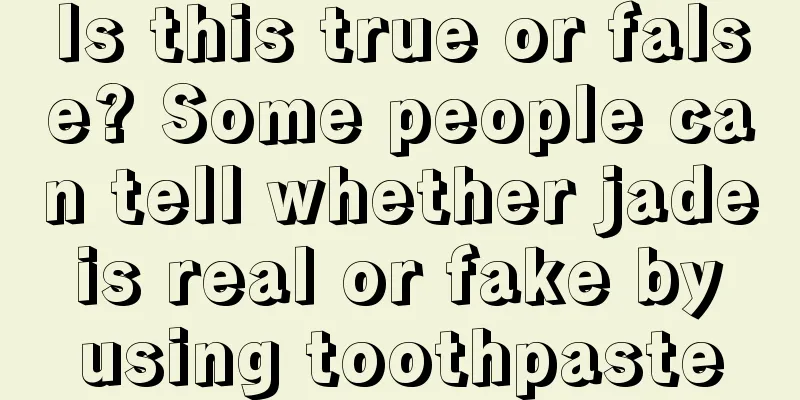Is this true or false? Some people can tell whether jade is real or fake by using toothpaste

|
Recently, a jade friend left a message saying that he found many tips on the Internet for identifying the authenticity of jade. One of them is particularly simple, which is to use toothpaste to identify it, but he doesn't know whether this method is effective. Today I will talk to you about this topic. The toothpaste identification method is to mix the toothpaste with the liquid, soak a paper towel in it, and then wrap the paper towel soaked with the mixed solution evenly on the jade jewelry and let it dry naturally in the sun. After waiting for it to dry, observe the color, hue, and feel of the jade. Fake jade will have obvious stains on the paper towel used to dry it, and it will feel rough to the touch, while the one that remains smooth and has no discoloration is the real thing. There is actually not much scientific basis for this identification method. Although toothpaste can clean jewelry, jade is afraid of acid and alkali. Toothpaste may damage the surface of jade to a certain extent, which would be counterproductive. Therefore, it is not recommended to use this method for identification. So, if you want to identify the authenticity of jade by yourself, what are some practical methods? 1. Magnifying glass You can use a magnifying glass to observe the inside of the jade to determine whether it has been acid-washed. Before B-grade jadeite is put on the market, it must be corroded with acid and alkali liquids, then cleaned and injected with glue. After this treatment, there will be lines on the surface of the jade, which are the acid-washing lines. A magnifying glass is a relatively reliable identification tool. By observing the reflective surface of the jade, it can clearly see whether there are such lines on the surface of the jade. Here we need to pay special attention to the difference between orange peel effect and acid etching. The orange peel pattern of jade is dot-shaped pits and pinholes, while the acid etching pattern has a network-like structure. 2. Flashlight The flashlight detection method is more about judging the texture of jadeite. The flashlight mentioned here is not an ordinary household flashlight, but a flashlight specially used for jade. When using this flashlight to look at jadeite, we should try to choose LED lamps and set the lumen light between 6 watts and 17 watts. By shining a flashlight directly at jade, you can observe the texture of jade and determine whether a piece of jade has a tight structure. When observing jadeite with a flashlight at an inclined angle (usually 45 degrees), the coarseness and fineness of the internal particles can be seen. The more obvious the grains are, the coarser the quality of the jade. In addition, by observing jade from multiple angles, you can also gain a more comprehensive understanding of jade's flaws, such as cracks and impurities. 3. Density measurement According to the density of jade, we can also conduct simple experiments at home, but we need to prepare the corresponding equipment: a portable commercial electronic scale with a bulk density of 1Kg and an accuracy of 0.1g, and a 1000ml beaker. Follow these steps to conduct the experiment: Fill the beaker with appropriate mineral water, place it in the center of the scale, and reset it to zero. Hang the jadeite with a thin rope and place it below the water surface in the beaker. It should not touch any part of the container. Pause for a moment, read the scale data and record it. For example: 13.1g Finally, sink the jadeite to the bottom of the beaker of water, read the scale data and record it. For example: 43.6g According to the formula, the first measured data 13.1g is divided by the second measured data 43.6g, that is 43.6/13.1=3.33 (g/cm3). The density is within the national standard range for jadeite. Combined with other testing steps, it can be determined whether this is A-grade jadeite. fcgc66 fcpf18 |
<<: Turn waste into treasure! This kind of carefully carved jade deserves to be valuable
Recommend
Buddha, learn to smile even in adversity
Buddha, also known as Maitreya, is one of the mos...
Do jade textures affect its value?
Lines are a very natural phenomenon of objects, s...
Jade carving theme: Snow-covered plum blossoms
Searching for plum blossoms in the snow is a comm...
What kind of jade is good jade?
The "green" of jadeite fully reflects t...
What kind of jade is worth collecting? Before collecting jadeite, take a look at these suggestions!
Customers often ask me how much jadeite needs to ...
Don’t know how to choose a jade bracelet? You will understand after reading this article
Jade is very suitable for people with yellow skin...
Jade is a tool, cultivating the inner self is the way
After the word "pan ta" in crosstalk be...
“Knowing how to buy” is more important than “controlling”! This is the standard for purchasing high-quality jadeite and a sample of good items
The pursuit of quality of life has gradually beco...
What does the lotus shape commonly seen in jade carvings mean?
There is an old saying in the jade industry that ...
Understanding the art of jade inlay and experiencing the beauty of icing on the cake
Inlay is a craft term. Inlay means to stick to th...
What is colorful jadeite, and why is it the "weirdope" among jadeites?
We all know that jade has a variety of colors. In...
I heard that jade has a "taste", have you ever tasted it?
A modest gentleman, gentle as jade, jadeite, with...
Important signs for identifying genuine jadeite!
Many people think that translucent and pure jade ...
Why are the jadeite items so expensive?
Many friends who are new to jade love it very muc...
What kind of jade has investment value?
Since entering the Chinese market, jade has been ...









